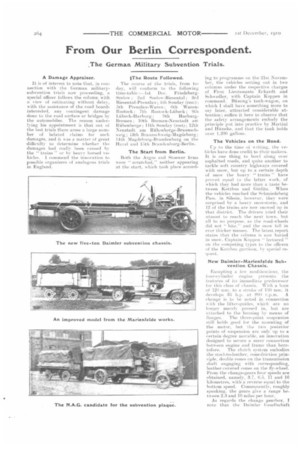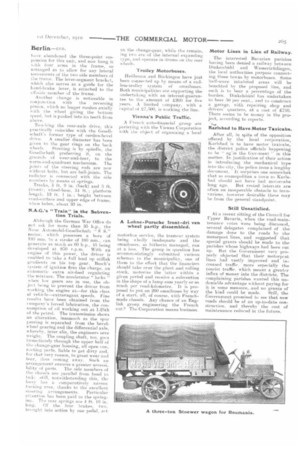From Our Berlin Correspondent.
Page 12

Page 13

If you've noticed an error in this article please click here to report it so we can fix it.
The German Military Subvention Trials.
A Damage Appraiser.
It is of interest to note that, in connection with the German militarysubvention trials now proceeding, a special officer follows the column with a view of estimating without delay, with the assistance of the road boards interested, any contingent damage done to the road surface or bridges by the automobiles. The reason underlying his appointment is that out of the last trials there arose a large number of belated claims for slick .damages, and it was a matter of great • difficulty to determine whether the damages had really been caused by the " trains " or icy heavy horsed vehicles. I commend the innovation to possible organizers of analagons trials in England.
The Route Followed.
The. course of the trials, from today, will conform to the following
time-table 7-1st Dec. FriedebergSeelow ; 2nd Seelow-Biesental; 3rd Biesental-Prenzlau ; .1tli Sunday (rest); 5th Prenzlau-Waren ; 6th WarenRostock ; 7th lioslock-Ltibeck ; Sib Li:Bieck-Ha rburg ; 9th HarburgBremen ; 10th Bremen-Neustadt am Rithenberge ; 11 tic Sunday (rest); 12th Neustadt am Rilbenberge-13ratinschweig; .1.3th Bratinschweig-Magtieburg ; 1.l Lb Magdeburg-B to ndenhurg on the
Havel ' el and 15tBrandenburg-Berlin.
The Start From Berlin.
Both the Argus and Stoewer firms were " scratched," neither appearing at the start, which took place accord ing to irogramme on the 21st November, the vehicles setting out in two columns under the respective charges of First Lieutenants Eckardt and Schwedler, with Captain Koppen in command. Biissing's tank-wagon, on which I shall have something more to say later, attracted considerable attention ; suffice it here to observe that the safety arrangements embody the principle put into practice by Martini and Hiineke, and that the tank holds over 1,200 gallons.
The Vehicles on the Road.
I7p to the time of writing, the vehicles have done credit to their makers. it is one thing to howl along over asphalted roads, and quite another to tackle soft country highways covered with snow, but up to a. certain depth snow the heavy " trains " have proved equal to the latter work, of which they had more than a taste between Kott bus and Gorlitz. When the vehicles reached the Schmiedeberg Pass. in Silesia. however, they were snri■rised by a heavy snowstorm, and 12 of the trains are now snowed up in that district. The drivers tried their utmost to reach the next town, but all to no purpose. as the road-wheels did not " bite," and the snow fell in ever thicker masses. The latest report states that the column is now buried in snow. Captain Koppel] " lectured " on the competing types to the officers of the Kottbus garrison. by special request,
New Daimler-Marienfelde Subvention Chassis.
Excepting a few modifications, the lotir-c.‘linder engine presents the
features of its immediate predecessor fm; this class of chassis. With a bore of 120 ram, to a stroke of 150 mm. it develops 35 hp. at 80i1 r.p.m. A
change is to be noted in connection with the lifter-guides, which are no
longer merely pressed in, but are attached to the housing by means of
flanges. The three-point Sc tspension still holds good for the mounting of tlie motor, but the two posterior points of suspension are only up to a certain degree movable, an innovation designed to secure a surer connection between engine and frame than here tofore. The clutch system embodies the steel-to-leather, cone-friction principle, double cones on the transmission shaft engaging with corresponding, leather-covered cones on the fly-wheel. From the change-gears four speeds are obtained, namely, 3.7, 6.5, 11 and 16 kilometres, with a reverse equal to the bottom speed. Consequently, roughly speaking. the gears give a range between 2.3 and 10 miles per hour.
As regards the change gearbox, I note that the Daimler Gesellschaft have abandoned the three-point suspension for this unit, and /tow hang it ith four arms in the frame, so arranged as to allow for any lateral movements of the two side members of the frame. The lever-segment bracket, which also serves as a guide for the hand-brake lever, is attached to the tiff-side member of the frame.
Another change is noticeable in con ii net ion with the reversing pinicn, which no longer meshes axially tvith the wheel giving the bottom speed, hut is pushed into its teeth from above.
Touching the rear-axle drive, this practically coincides wi th the Gesellschaft's former typo of eardan-bevel drive. A smaller diameter has been given to the gear rings on the lntek wheels. Steering is by spindle, the Gesellschaft preferring it, on the grounds of wear-and-tear, to the worm-a nd-quadrant mechanism. The joints of the steering rods are now without. bolts, but are ball-joints. The radiator is connected with the side members by means of springs.
Tracks, 4 ft. 9 in. (back) and 5 ft. (front); wheel-base, 14 ft. • platform
length. 13 ft. 1 in height between road-surface and upper edge of frame, when laden, about 33 in.
N.A.G.'s "Train" in the Subvention Trials.
Although the German War Office do not, ask for more than 35 h.p., the Nene Automobil-Oesellschaft " 8 S." motor, which possesses a bore of 1::10 rum, to a stroke of 160 mm., can generate as much as 60 h.p., 45 being developed at 850 r.p.m. With an engine of this power, the driver is enabled to take a full load up stiffish gradients on his top gear. Bosch's system of ignition fires the charge, en entomatie extra air-feed regulating the mixtm.e. The accelerator " locks " when low gears are in use, the ohjeet being to prevent the driver from working the engine at—for this elass of vehicle—extravagant speeds. Fine results have been obtained from the company's forced lubrication, the consumption of oil working out at 1-25th of the petrol. The transmission shows an alteration, inasmuch as the spur gearing is separated from the bevelwheel gearing and the differential axle, whereby, inter alia, the engineers save weight. The coupling shaft, ten, goes immediately through the upper half of the ehange-gear housing, all open eon_ necting parts, liable to get dirty and. for that very reason, to great wear and tear, illes coming away. Such art nrrangement ensures a greater aecessibility of parts. The side memhers of the chassis are parallel from head to tail': still, notwithstanding this, the lorry has a comparatively narrow turning area, thanks to the eseellent steerieg arrangements. Particular attention has been paid to the springing. -rtc rear springs are 4 ft. 10 in. long. Of the four brakes, two, brought. into action by one pedal, net on the change-gear, while the remaining two are of the internal expanding type, null operate in thorns on the rear tu heels.
Trolley Motorbuses.
Heilbronn and Bikkingen have just been connected up by means of a railless-trolley system of omnibuses. Both municipalities are supporting the undertaking with an interest-guarantee to the amount. of 1:300 for five years. A limited company, with a capital of t7,500, is working the line.
Vienna's Public Traffic.
A French auto-fieancial group are parleying with the Vienna Corporation with the object of organizing a local motorbus service, the tramcar system being wholly inadequate and the omnibuses, as hitherto managed, run at a loss. The group in question has accommodatingly submitted various schemes to the municipality, one of them to the effect that the financiers should take. over the plant and rolling stock, motorize the latter within a given period and receive a subvention in the shape of a lump mini yearly or so much per road-kilometre. It is proposed to pet on 200 omnibuses by way of a start, all, of course, with Frenchmade chassis. Any chance of an English group engineering the French out ? The Corporation means business. Motor Lines in Lieu of Railway.
The interested Bavarian parishes having been denied a railway between Dinkeisliiihl and Wassertriidingen, the local authorities purpose connecting these towns by motorbuses. Some half-score inhabited areas will be benefited by the proposed line, and each is to bear a percentage of the burden. Dinkelsbithl has undertaken to bear 50 per cent., and to construct a garage, with repairing shop and drivers' quarters, at a cost of £750. There seems to be money in the project, according to reports.
Karlsbad to Have Motor Taxicabs.
After all, in spite of the opposition offered by the local corporation, Karlsbad is to have motor taxicabs, the district police officials happening. to he " ag'in the Guy-merit. '' in this matter. In justification of their action in introducing the mechanical type into the city, the police issue a lengthy document. It surprises one somewhat that so cosmopolitan a town as Karlabad should not linve had motorcabs
long ago. But vested interests are often an insuperable obstacle to innovations, however desirable these maybe from the general standpoint.
Still Unsatisfied.
At a recent sitting of the Council for Upper Bavaria, when the road-maintenance votes were being discussed, several delegates complained of the damage done to the roads by the motorpost lines, and suggested that special grants should be made to the parishes whose highways had been cut up. But the Governtnent very properly objected that their mntorpest lines had vastly improved and increased traffic, more especially the tourist, traffic, which meant a greater influx of money into the districts. The complaining parishes wanted this undeniable advantage without paying for it in tioille measure,. and no grants of'
the kind could be made. Still, the Government promised to see that new roads should be of an up-to-date (*instruction. and thereby the cost of maintenance reduced in the future.




















